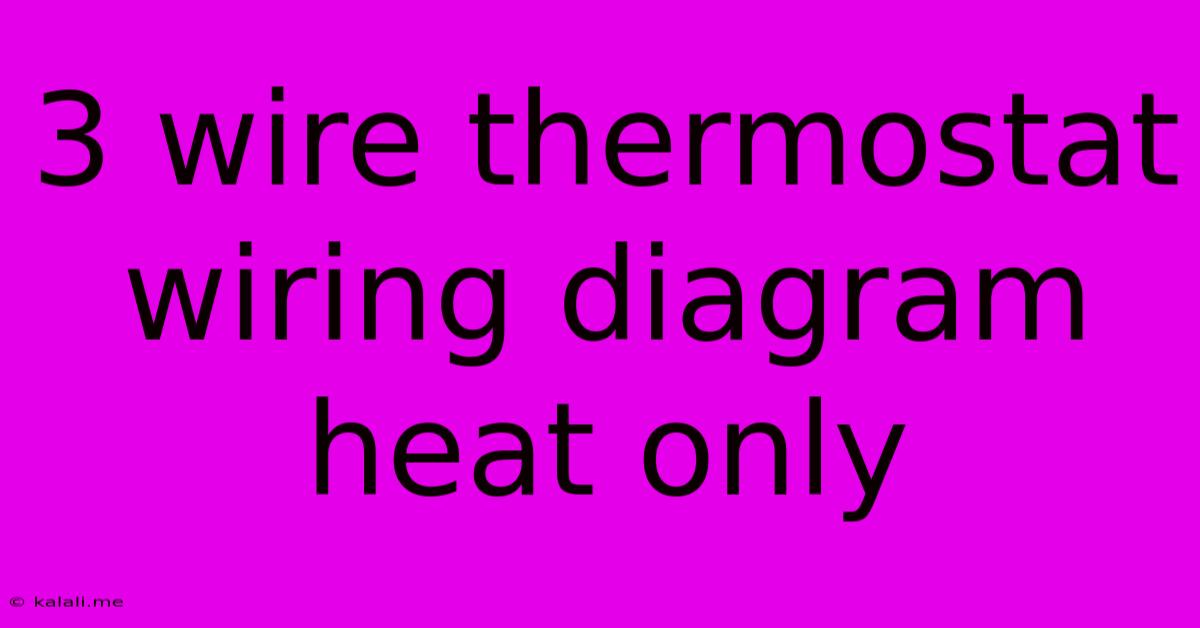3 Wire Thermostat Wiring Diagram Heat Only
Kalali
May 25, 2025 · 3 min read

Table of Contents
3-Wire Thermostat Wiring Diagram: Heat Only Systems Explained
This article provides a comprehensive guide to understanding and utilizing a 3-wire thermostat wiring diagram for heat-only systems. We'll break down the process step-by-step, covering common wiring configurations and troubleshooting tips for a successful installation. Understanding this simple yet crucial aspect of home heating ensures efficient and safe operation of your furnace.
Understanding the Basics: Why Only 3 Wires?
A heat-only system, unlike those with air conditioning, only requires control over the heating element. This translates to fewer wires compared to systems with both heating and cooling capabilities. The three wires typically involved are:
- Red wire (R): Provides power to the thermostat. This is usually the "hot" wire directly from your electrical system.
- White wire (W): Controls the heating element in your furnace. The thermostat closes this circuit to turn the furnace on.
- Common wire (C): Provides a continuous power supply to the thermostat's internal circuitry. While not strictly necessary for basic functionality in some older systems, it's highly recommended for modern thermostats, ensuring accurate and reliable operation.
Common 3-Wire Thermostat Wiring Diagrams:
While variations exist, a typical heat-only wiring diagram looks like this:
Diagram: (Imagine a simple diagram here showing a thermostat with R, W, and C terminals connected to corresponding wires leading to the furnace. You can't create visual diagrams in this text format. A visual aid would be highly beneficial here in a real-world article.)
Explanation:
- Thermostat: Shows the R, W, and C terminals clearly labeled on the thermostat base.
- Wires: Illustrates the three wires (red, white, and common) connected to their corresponding terminals.
- Furnace: Shows the corresponding terminals on the furnace's wiring board.
Important Note: Always refer to your specific thermostat and furnace manuals for exact wiring instructions. Improper wiring can lead to malfunction or even safety hazards.
Troubleshooting Common Issues:
- Furnace Doesn't Turn On: Check for power at the thermostat and the furnace. Ensure all wire connections are secure and that the circuit breaker isn't tripped. A faulty thermostat or furnace may also be the cause.
- Thermostat Display Doesn't Work: Verify the presence of a common wire (C). If missing, you might need to add one, following the manufacturer's guidelines. A dead battery (if applicable) or faulty thermostat are other potential reasons.
- Inconsistent Heating: Check for air filters, clogged vents, or issues with the furnace itself. A malfunctioning heating element or blower motor could also be to blame.
Why a Common Wire (C) is Crucial:
While some older systems may operate without a common wire, modern thermostats rely on a constant power source provided by the common wire (C). Without it, the thermostat may drain the power from the R wire, leading to inconsistent readings, inaccurate temperature control, and potentially premature failure of the thermostat. Adding a C wire greatly enhances performance and lifespan.
Upgrading to a Smart Thermostat:
Many homeowners choose to upgrade to smart thermostats. These offer features such as programmable schedules, remote control, and energy monitoring. While the basic wiring remains similar, always consult the smart thermostat's installation guide for specific instructions, as they may have different wiring configurations or requirements.
Safety Precautions:
- Turn off power: Always disconnect power to both the thermostat and furnace before any wiring work.
- Consult professionals: If you're uncomfortable working with electrical wiring, consult a qualified electrician or HVAC technician. This will ensure correct installation and prevent potential safety hazards.
By understanding the simple workings of a 3-wire thermostat wiring diagram for heat-only systems, you can effectively manage your home's heating system and enjoy a comfortable and energy-efficient living environment. Remember, safety always comes first, so consult a professional if needed.
Latest Posts
Latest Posts
-
Areas To Avoid In San Francisco Map
May 25, 2025
-
Can Spark Heal Soldiers In Xcom 2
May 25, 2025
-
Fallout New Vegas Power Armor Training
May 25, 2025
-
How To Replace Flange For Toilet
May 25, 2025
-
Oil Based Versus Water Based Polyurethane
May 25, 2025
Related Post
Thank you for visiting our website which covers about 3 Wire Thermostat Wiring Diagram Heat Only . We hope the information provided has been useful to you. Feel free to contact us if you have any questions or need further assistance. See you next time and don't miss to bookmark.